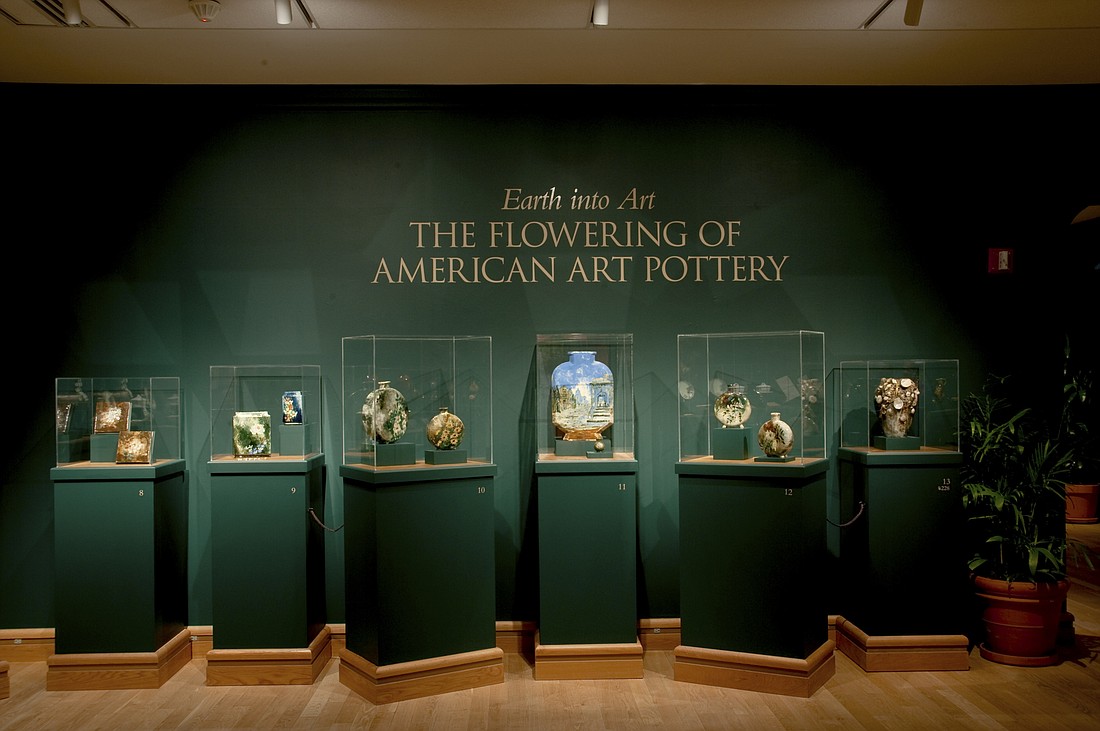- April 19, 2024
-
-
Loading

Loading

Quite a few things happened at the Centennial International Exhibition in Philadelphia in 1876. Alexander Graham Bell demonstrated his new telephone invention to the public. The torch-bearing arm of the Statue of Liberty was put on display for guests to explore.
And, important to the country’s art scene, a new pottery style was vaulted into public consciousness.
The Morse Museum of American Art’s “Earth into Art — The Flowering of American Art Pottery” exhibit examines the history of the distinctly American style of art. The craft, which enjoyed more than 40 years of popularity from 1876 to 1915, is considered to be the first of America’s international original art styles, according to Jennifer Thalheimer, Morse Museum’s curator and collection manager.
The exhibit, which wraps in fall 2020, tracks the pottery movement’s beginnings and style variations over the decades.
There are more than 100 pieces in the museum that reflect the evolving tastes and techniques of artists in the late 19th and early 20th centuries. One-third of the pottery pieces were gifts given to the museum from Herb and Susan O. Robinson in the 1980s.
Thalheimer believes this exhibit is particularly comprehensive in tracking the art style’s progression over the years. Many of the pieces on display are marked and dated from the various creators. Morse staff spent a couple of years gathering information on the various ceramics. Catherine Hinman, director of public affairs and publications, said the process has been like gathering string.
“You want it to be something beautiful,” Thalheimer said. “It’s great to have information, but you want people to look at the objects and realize how beautiful they are. You want to be able to project what’s important about every single object, as well.”
1876 Centennial International Exhibition
The Centennial International Exhibition in Philadelphia in 1876 marked the beginning of the art pottery phenomenon in America.
The exhibition’s displays of painted porcelain from France and Japan were an immediate hit among American artists and patrons, Thalheimer said. The ceramic process for these pieces was relatively simple. Color and a paste-like material called flux was applied to a glazed ceramic. It then would be placed in a kiln to fuse the paint and flux to the pottery. The pots also would include illustrations and directions to make things easier for beginning artists.
Furthermore, the new art style was introduced at a time when women were fighting for equal rights and, coming out of the Civil War, looking for ways to make an impact on the world.
“It was around the time women were fighting for the suffrage movement,” Thalheimer said. “Your vocation was going to be stay-at-home mom or a teacher. For the first time, it was something that they could do as a profession, and it was respected. It gave them new opportunities.”
Two women in particular were the driving force behind the art style, according to the exhibit. Mary Louise McLaughlin and Maria Longworth Nichols both were talented china painters inspired by what they saw at the Centennial International Exhibition. It pushed them to do more, Thalheimer said.
McLaughlin developed the “Barbotine” pottery technique after seeing it at the exhibition and published an influential decoration manual and organized the Cincinnati Pottery Club in 1879.
“(McLaughlin) really took on the challenge that many men couldn’t do,” Thalheimer said. “Which is to figure out the formula that had been done in France to do this under-the-glaze technique.”
Nichols, who came from a wealthy Cincinnati family, started the Rookwood Pottery organization to better support art pottery decorators than the existing commercial pottery organizations. Thalheimer said Rookwood is now one of the most well-known pottery brands today.
Pottery Styles
Barbotine Pottery
Barbotine pottery differed from china painting in that it was decorated before glazing. Mary Louise McLaughlin picked up on the method and documented her approach in her 1880 book, “Pottery Decoration Under the Glaze.” Her pottery style — called “Cincinnati Limoges” — was picked up by and encouraged by fellow artist Maria Longworth Nichols.
Rookwood Exotic
Japanese ceramic displays at the Centennial International Exhibition have flora and fauna designs with a bird’s eye perspective that quickly enamored American audiences. Rookwood artists created pieces based on Asian ceramics and included off-beat animals such as bats or spiders in the designs.
Rookwood Botanical
Floral designs remained the most popular at Rookwood; many of the women who painted china also were enthusiastic gardeners. This led to tonalism, which blended deep colors with smoky tones that went well with the photorealistic flowers adorning the ceramics.
Rookwood Realistic
Near the end of the 19th century, Rookwood artists turned black-and-white photographs of Native-American chiefs into colorful portraits on ceramics. Each piece included the name and nation of the Native-American leader.
Art Pottery History Lecture Series
The Morse Museum will host a series of free lecture series on the American Art Pottery Exhibit on select Wednesdays starting Jan. 30 at the Jeannette G. and Hugh F. McKean Pavilion, 161 W. Canton Ave., Winter Park.
American Art Pottery and the Museum of Fine Arts, Boston: The Early Years
WHEN: 2:30 p.m. Jan. 30
SPEAKER: Nonie Gadsden, Katharine Lane Weems senior curator of American Decorative Arts and Sculpture at the Museum of Fine Arts in Boston
A Most Exquisite Display: European Ceramics at the Centennial Exhibition
WHEN: 2:30 p.m. Feb. 13
SPEAKER: Donna Corbin, independent curator in Philadelphia
Adelaide Alsop Robineau, America’s Finest Ceramist
WHEN: 2:30 p.m. March 6
SPEAKER: Martin Eidelberg, Author and Professor Emeritus of art history at Rutgers University in New Jersey
American Art Pottery: The Robert A. Ellison Jr. Collection at The Metropolitan Museum of Art
WHEN: 2:30 p.m. April 3
SPEAKER: Alice Cooney Frelinghuysen, The Anthony W. and Lulu C. Wang curator of American Decorative Arts at the Metropolitan Museum of American Art in New York City